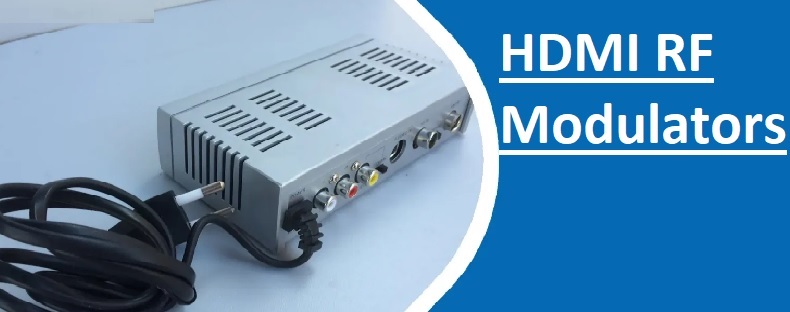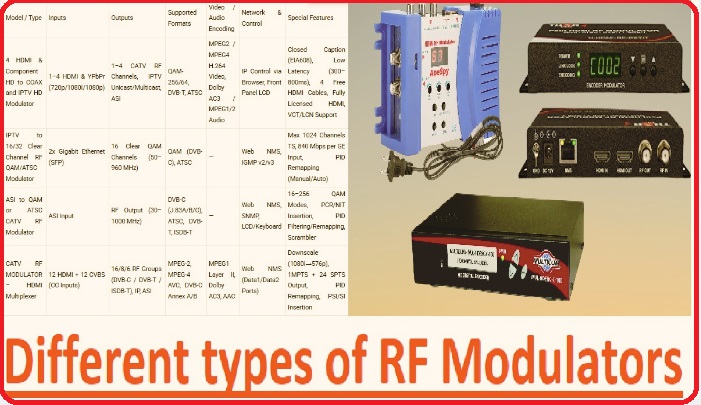An HDMI RF modulator component that transforms an HDMI signal into a radio frequency signal. With this feature, HDMI-supported devices, like streaming devices, send video and audio data via coaxial cables. It was used for older TVs and distribution systems that operated with RF signals.
HDMI RF modulators are the main part of the TV system that is used in hotels and old buildings. In this tutorial, we will cover details about HDMI RF and related factors. So let’s get started.
What HDMI RF Modulator
- An HDMI RF modulator is used for the conversion of an HDMI signal into an RF signal that moves through normal coaxial cables.
- In this way, a video signal is transmitted from a single HDMI device, such as a camera or media player, to different TVs at the same time.
- This is a low-cost option for reusing existing coaxial cable and making connections of advanced devices with older systems.
- Some modulators are compatible with HD video of 1080p and transmit with clear audio.
- The plug-and-play model is used with advanced settings for customization
HDMI RF Modulator working
- An HDMI RF modulator converts an HDMI signal into a radio frequency signal that moves through a coaxial cable.
- It helps to connect advanced HDMI devices, such as streaming boxes, with older TVs that come with a single antenna port.
- Simply with this modulator, the HDMI signal is converted into a TV channel that shows on the tuner display.
- The internal structure of the modulator performs this function. HDMI input → encoding → modulation → RF output.
- First of all, the device encodes the HDMI video signal and audio into digital form, then transforms it into an RF signal.
- This signal moves through a coaxial cable and transmits to different TVs at the same time.
- With this configuration, HDMI is shared with different screens.
- Different types of models operated with different broadcasts like QAM, ATSC, and DVB-T, according to location.
- Some supported video compression formats such as MPEG2, H.264, or H.265, and transmitted AC-3 audio.
- There is an option to set the RF power channel and gain for the setup configuration without interference, giving a clean signal.
Related posts Pulse-Width Modulation Inverters, Types and Applications
HDMI RF Modulator, Features
Some common features of the HDMI RF modulator are as
Resolution and Frame Rate
- Some modulators support 1080p HD, and new models are compatible with 4K. High frame rates help to provide clear and smooth results.
Latency and Sync
- A proper condition modulator provides a delay in slow speed that makes synchronization in video and sound. that helps to add security features and is used for live streaming
Output Quality:
- Variable RF power helps to make a configuration according to the length of the cable. built-in isolation features, clean signal transmission through minimizing noise
Channel Range
- There is a TV channel selection option available. Some modules operated for the VHF and UHF bands.
Multi-Input Support
- Some types of HDMI RF modulators can handle multiple HDMI sources simultaneously, transmitting each to a separate channel.
Build and Cooling
- It comes with a strong metallic structure and ventilation for reducing the modulator temperature and stable working.
Installation process of the HDMI RF Modulator
The HDMI RF modulator installation process is easy and accurate. Installation makes it effective to use.
Coaxial Line
- For accurate installation of the RF modulator, it uses quality coaxial cable that has an impedance of 75 ohms for proper signal stability. not use low-cost cable that can be damaged by signal flow and cause signal losses.
- Before using splitters, use the same frequency as the modulator has.
Output Power
- Each structure comes with a different setup; for TV connection at a short distance, use low RF output power. For longer connections, a high-power cable can be used. But avoid very high power that affects noise and causes interference.
Channel setting
- Set a channel number that is not selected on any other device or broadcast. Set a minor gap between channels to minimize crosstalk, which helps the signal to move uniformly
Integrating with Older Systems
- Before connecting the RF modulator with the already installed system, first check the signal level. For this purpose, use a mixer used for configuration to a new channel with an older system that operates system-in-balance features.
Maintenance
- For smooth working, check the signal-to-noise ratio and bit error rate. Regularly clean connectors and tighten cable connections for strong signal transmission.
Multiple Modulators
- If you are using a larger setup, a different HDMI modulator can be used. With this design, use a distribution amplifier that maintains signal strength.
- Define each modulator for tracing the channel easily
Different types of RF Modulators
Related posts PLC vs. Microcontroller: Which is Right for Your Project?
Model / Type | Inputs | Outputs | Supported Formats | Video / Audio Encoding | Network & Control | Special Features |
| 4 HDMI & Component HD to COAX and IPTV HD Modulator | 1–4 HDMI & YPbPr (720p/1080i/1080p) | 1–4 CATV RF Channels, IPTV Unicast/Multicast, ASI | QAM-256/64, DVB-T, ATSC | MPEG2 / MPEG4 H.264 Video, Dolby AC3 / MPEG1/2 Audio | IP Control via Browser, Front Panel LCD | Closed Caption (EIA608), Low Latency (300–800ms), 4 Free HDMI Cables, Fully Licensed HDMI, VCT/LCN Support |
| IPTV to 16/32 Clear Channel RF QAM/ATSC Modulator | 2x Gigabit Ethernet (SFP) | 16 Clear QAM Channels (50–960 MHz) | QAM (DVB-C), ATSC | — | Web NMS, IGMP v2/v3 | Max 1024 Channels TS, 840 Mbps per GE Input, PID Remapping (Manual/Auto) |
| ASI to QAM or ATSC CATV RF Modulator | ASI Input | RF Output (30–1000 MHz) | DVB-C (J.83A/B/C), ATSC, DVB-T, ISDB-T | — | Web NMS, SNMP, LCD/Keyboard | 16–256 QAM Modes, PCR/NIT Insertion, PID Filtering/Remapping, Scrambler |
| CATV RF MODULATOR – HDMI Multiplexer | 12 HDMI + 12 CVBS (CC Inputs) | 16/8/6 RF Groups (DVB-C / DVB-T / ISDB-T), IP, ASI | MPEG-2, MPEG-4 AVC, DVB-C Annex A/B | MPEG1 Layer II, Dolby AC3, AAC | Web NMS (Data1/Data2 Ports) | Downscale (1080i→576p), 1MPTS + 24 SPTS Output, PID Remapping, PSI/SI Insertion |
| 8 Channel HDMI & SDI Clear CATV RF Modulator | 8 HDMI & SDI (Individually Selectable) | 8 RF Channels (QAM, ATSC, DVB-T, ISDB-T) | DVB-C Annex A/B (64/256 QAM), ATSC 8VSB, ISDB-T | MPEG2 Video, Dolby AC3 / MPEG1 Layer II / AAC | Web GUI + Front LCD | 1080p Full HD, Low Latency (500/1000ms), SDI CC708 Support, Frequency 50–900MHz, LED Input Indicators |
Selection factor of the Right HDMI RF Modulator
different factors involved in the selection of an HDMI RF modulator according to circuit requirements and area. Some factors are as
Standard for location
- Different regions employ different TV broadcast systems. So use a modulator that is compatible with accurate ATSC for the USA; in Asia and Europe, use DVB-T, and cable networks use QAM. The use of accurate standards operates the TV accurately.
Resolution
- Make sure how many HDMI sources require connection and the number of TV channels needed to make. If a single channel is needed, use the basic model. For more input or getting 4k video, use the upgraded version of the modulator.
Latency
- Low delay is important for modulator use in live streaming and surveillance. So use a modulator that supports quality video and audio synchronization with low losses.
Signal Strength
- Use a modulator for a circuit that can adjust RF output power. That makes the configuration between cable length and minimizes interference. With these modulators, we can send signals for longer distances.
Control and Interfacing
- Find options that handle different features such as front panel buttons and remote network access. These features help to make it easy to set for larger connections.
Brand
- Get service from a famous brand that gives quality work and a supported warranty. They are also reliable and control devices 24/7 in hotels or commercial setups.
Cost
- Some basic models are low-cost and used for small projects. But high-end modules are high cost but provide quality results, a high number of ofchannelsand send data over longer distances.
- Select a module that is compatible with all systems at a good cost.
RF modulator Uses
Related posts MAF Sensor, Features, Working, Uses
- RF modulator configured with VCRs and video game consoles, also part of 4th generation consoles and 8- and 16-bit home computers.
- Some modules come with an external modulator unit that is configured with the system and antenna jacks of the TV.
- RF modulators are also used for getting audio and video signals from RGB, YUV, PAL, and other sources, and also produce RF signals that transmit through TV or coaxial connectors.
- Multi-channel RF modulator is part of home video and audio transmission. These devices come with different audio and video inputs and one RF output.
- signal output from source devices like DVD players, VCRs, and DSS receivers connected with inputs over modulators.
- modulator programmed to broadcast signals at a certain frequency. RF broadcasts get on connected TV.
- If the TV is on for a programmed channel, the video and audio signal of the source device connect.
HDMI RF Modulators Setup Process
- First of all, make a connection of the HDMI cable of the device PC with the HDMI input of the modulator. Check that the device turns on and is transmitting the video signal.
- Make a connection of the coaxial cable of the modulator for RF output with the TV, and the splitter connects different TVs. secure connection for reducing signal losses
- on the modulator, HDMI source, and TV. Check indicator lights or check the display of the modulator for accurate working.
- Apply the TV auto scan working for get the modulator output channel. The manual channel can be set if we know.
- work on the modulator menu for changing resolution, audio, and channel adjustment for good working
FAQs
Is it possible for the HDMI RF modulator to handle HDCP-protected content?
- It is based on model type; some types of HDMI RF modulators have High-bandwidth Digital Content Protection features that prevent blocking of protected streams.
- Some do not show video for encrypted content. Make sure your module is using HDCP compatibility if needed.
Will visible compression cause quality loss?
- • The modulator compresses and encodes the HDMI signal before modulation, so minor changes can be seen. A high-end modulator uses good encoders and high bit rates for reducing losses. In some content, degradation is accepted.
Is it possible to mix RF and IP streaming in a single system?
- Different system compatible with the hybrid system, part of the video transmitted on radiofrequency through an HDMI RF modulator, and the remaining part sent through IP. That provides flexible working; if one path is not working, the other can be used. For integration, proper channel setting, synchronization, and latency balancing are needed.
How much distance can the RF signal transmit over coax before quality is affected?
- If you use good-quality cable and accurate output power, the signal can cover hundreds of feet with good quality. but ranges based on cable, connectors, splitters, and power losses.
- If transmitting data for longer distances, a boosting amplifier circuit is used.
Are HDMI RF modulators compatible with HDR or advanced video features?
- HDMI RF modulator not compatible with advanced video features such as HDR, HLG, or Dolby Vision.
- It was made for converting HDMI signals into a format that supported older versions of coaxial cable systems and did not have the required bandwidth and processing features.








